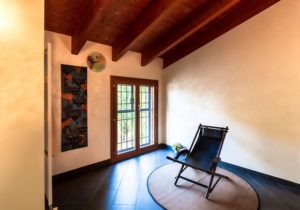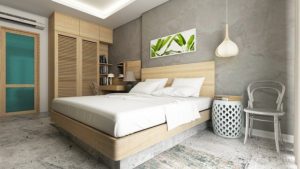Years ago, I lived in a long, low rambler of a house that sat on a corner lot. My husband and I did some renovating which resulted in the entire yard being torn up. When it came time, we replanted the yard with grass seed (no sod for us!) and had to replace the walkway leading to the front door. I can’t remember what the original sidewalk was made of now, but it made a straight beeline from the road to the front door.
A friend who was a landscape designer suggested that we add a slight curve to the sidewalk to soften the perpendicular lines in our yard, which we did. The final walkway was a gently curving “S” to the front door, made from stamped concrete, which looked like flagstones.
The simple change from a straight walkway to one that was curved was transformative. It softened the entire entryway to our home, gently leading visitors to the front door. And it removed the severe perpendicular lines from our front yard, making the rounded edges of the small garden in the front look more appealing. While I’m writing about simple Feng Shui solutions, I acknowledge that replacing a front sidewalk is not easy or inexpensive, but the simplicity was in making one small change; adding a curve to a sidewalk that had to be replaced anyway.
Feng Shui is based on the principles of Qi, or energy, that flows though not only your body, but your environment as well. There are a number of complicated principles associated with Feng Shui, some of which can involve rearranging furniture, moving walls and repositioning windows. However,  Feng Shui is also about how you feel in your space, and the ways your space can help make you feel better. Think about how chaotic and stressed you feel when you walk into a messy home that’s full of clutter with last night’s dishes still in the sink. Compare that to how you feel when you sit in a clutter-free room that’s open and airy. Much better, right? That’s the power of Feng Shui. And it doesn’t have to involve huge fixes or structural work. Here are a few simple changes that can transform your home:
Feng Shui is also about how you feel in your space, and the ways your space can help make you feel better. Think about how chaotic and stressed you feel when you walk into a messy home that’s full of clutter with last night’s dishes still in the sink. Compare that to how you feel when you sit in a clutter-free room that’s open and airy. Much better, right? That’s the power of Feng Shui. And it doesn’t have to involve huge fixes or structural work. Here are a few simple changes that can transform your home:
- Lose the clutter. The simple truth is that clutter feels bad. It’s chaotic and stressful. I get it; sometimes life is busy and things get out of hand. But clutter only aggravates your stress and makes you feel more overwhelmed. Take the time to put away or throw away the stuff that’s making your home a mess.
- Find creative ways to maximize your storage. This will help with the clutter. Use beds with storage underneath, find tables with drawers, maximize the space in your linen closet, hang a few extra shelves in a closet and find accessories that double as storage space, such as side tables, baskets and decorative boxes.
- Include art that is inspiring. Images from nature, travel photographs and objects that feel good to you are more important than finding the
 exact right item for the space. Art that you like is actually good for your mental health.
exact right item for the space. Art that you like is actually good for your mental health. - Use sound, such as wind chimes, soft music or a water fountain to help disperse noise from the outside world. I live about a half mile from a highway. Some days the sound seems really loud, but the wind chimes outside my door not only help diffuse the highway noise, but are also relaxing to hear.
- Bring elements from nature inside. This can take the form of natural building materials, such as wood or stone, photos or paintings of natural scenes or painting your walls in earthy tones.
- Plants are also a good way to bring elements of nature indoors; not only do they improve the air quality, but they’re also actually good for your health. Studies have found that indoor plants can decrease stress, boost creativity, lower your blood pressure and lengthen your attention span.
- Optimize natural light. Sunlight helps regulate your biological clock and has a positive effect on the feel-good neurotransmitter serotonin. If
 you have curtains, keep them open during the day and position your bed so that you’re exposed to the morning sunlight. If your home is not particularly well-lit, add a mixture of light sources to brighten up dark spaces.
you have curtains, keep them open during the day and position your bed so that you’re exposed to the morning sunlight. If your home is not particularly well-lit, add a mixture of light sources to brighten up dark spaces. - Control your electronics. Electrical devices, computers, charging stations and the like are disturbing and mix up the energy in a room. If possible, keep your electronics in your office space, kitchen or den—not your bedroom, where they can mess with your sleep.
- Along this same line, don’t store your gym equipment in the bedroom.
- Choose colors for your home that feel good. Earth tones can boost your mood, without being overly bold. Light blues and greens, as well as lavender tend to be calming, and are ideal for bringing serenity to your bedroom. Avoid overly activating colors such as black, bright red or orange, unless used as small accents.
- Getting a pet is never a simple hack, but if you’re thinking about getting one, know that animals are good Feng Shui. Animals tend to be playful and happy, add another dimension to your life and can help boost your mood. In addition, the activity of a pet in your home helps move energy around the house, especially a dog with jingly tags or a cat with a bell on its collar.
The bottom line is that while the principles of classical Feng Shui can be complicated and nuanced, making changes in your home that boost your mood and actually improve your health aren’t difficult. A tweak here or there can be enough to create a relaxing space that feels good to you.



